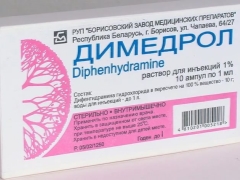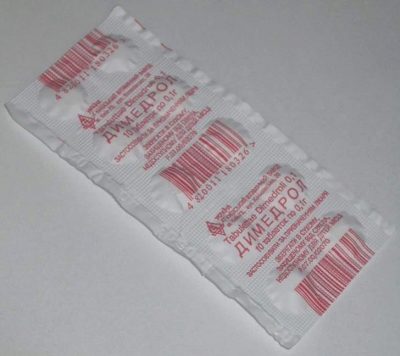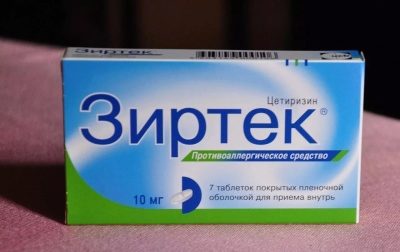"Dimedrol" for children: instructions for use
"Dimedrol" is one of the most well-known antihistamines. Such a drug was created many decades ago, but today it is used in allergic reactions or fever. Not everyone knows whether it is possible to use it in childhood, as such a drug affects the child's body.
Release form
Dimedrol is produced in two forms:
- Ampoules with one-percent colorless transparent solution that can be injected into muscle tissue or into a vein. One ampoule contains 1 ml of medicine, and in one box there are 10 ampoules.
- Tablets of a round form of white color, placed on 10 pieces in the blister or paper packing. They are sold for 10-50 pieces in a pack.
Composition
The effect of "Dimedrol" is provided by an ingredient called diphenhydramine. In 1 ml of solution it is presented in an amount of 10 mg, and in one tablet - a dosage of 50 mg.
Additionally, the injection solution contains only sterile water, and the tablet auxiliary substances are stearic acid, silicon dioxide, lactose monohydrate, corn starch and methylcellulose.
Operating principle
Dimedrol has the ability to act on receptors for such an allergic mediator as histamine. By blocking these receptors, the drug quickly relieves puffiness, smooth muscle spasm, and also helps eliminate itching and other allergy symptoms.
In addition, the drug is different sleeping pills and a sedative effect, because it affects the histamine receptors in the brain, and is also able to inhibit the cholinergic structures of the brain (this action is characteristic of first-generation antihistamines). The drug has some local anesthetic and antiemetic effect.
Taken inside the pills begin to act after about 20-40 minutes, and the therapeutic effect lasts up to 4-10 hours. With injections, the effect of the drug is observed after a few minutes, and it lasts up to 12 hours. After metabolic changes in the liver, the active substance "Dimedrol" is completely eliminated by the kidneys during the day after administration.
Indications
The drug is in demand:
- With anaphylactic reactions.
- With angioedema.
- When urticaria.
- With allergic rhinitis.
- With serum sickness.
- With allergic conjunctivitis.
- When itchy dermatosis.
- When chickenpox to reduce itching bubbles.
- With airborne (or marine) disease.
- For insomnia.
- In other allergic conditions.
“Dimedrol” is also often used for emergency care for children with high body temperature. In this situation, it is combined with Analgin, and sometimes a third drug from the group of antispasmodics is added ( "No-shpu", «Papaverine» or «Drotaverinum»). This combination of medications eliminates vascular spasm and quickly normalizes body temperature, which is especially important if hyperthermia is life threatening to the patient (for example, at high risk of seizures).
In addition, a combination drug is produced, including "Dimedrol" and "Analgin", in the form of candles. This tool is called «Analdim». It is used for children from 1 year - with a high body temperature or severe pain.
With a cold or sinusitis with a protracted course of ENT, doctors can prescribe complex drops with "Dimedrol", which also include antiseptics, vasoconstrictor agents, antibiotics and other medicines. For the manufacture of such drops using an injection form of medication, and the prescription and dosage doctor selects individually.
In case of laryngitis and false croup, the doctor may prescribe inhalations with Dimedrol, for which a nebulizer is used. This administration of the drug allows him to get directly to the place of smooth muscle spasm and edema, as a result of which such muscle fibers relax and the swelling decreases.
At what age is it allowed to take?
Injections "Dimedrol" are used for children older than a year, but in some cases, the doctor may prescribe such medicine and an infant up to one year (from 7 months). The tablet form can also be used at different ages, but often this “Dimedrol” is prescribed to children over 7 years old, who can easily swallow the drug.
Contraindications
The drug is not prescribed:
- In case of intolerance to diphenhydramine and other ingredients of the drug.
- With angle-closure glaucoma.
- With ulcerative lesions of the stomach.
- With epilepsy.
- With bladder neck stenosis.
Increased attention of medical staff requires the use of the drug for children with asthma.
Side effects
When treating "Dimedrol" arise:
- Weakness, deterioration of psychomotor reactions and coordination, drowsiness, hand trembling and other negative reaction of the central nervous system. In childhood, nervous excitement often appears and sleep is disturbed.
- Dry nasal or mouth mucosa.
- Violation of blood, resulting in hemolytic anemia develops and decreases the level of other blood cells.
- A decrease in blood pressure, an increase in heart rate, or the appearance of extrasystoles.
- An allergic reaction - for example, itchy skin or urticaria.
- Impaired urination
Instructions for use and dosage
At home, it is permissible to do only intramuscular injections, and the introduction of the drug into a vein should be controlled by doctors, so it is carried out only in the hospital.
A single dose of injections depends on age:
- Baby 7-12 months, the drug may be administered by a doctor (at a dose of 0.3-0.5 ml).
- To kid 1-3 years during one injection injected 0.5-1 ml solution.
- For babies 4-6 years the volume of the drug for 1 injection amounts 1-1,5 ml.
- For a child older 7 years and until 14 year old age a single dose will be 1.5-3 ml medication.
- AT 14 years and older for a single injection take from 1 before 5 ml solution.
Injection, if necessary, repeat after 6-8 hours.
Tablet "Dimedrol" child over 7 years usually give by 1/4 tabletbecause the dosage of such a medicine for children 6-12 years is 15-30 mg. Younger child 6 years, the doctor picks up the dose. Pill Frequency - 1-3 once a day, and the duration of treatment with such a drug can be up to 10-15 days
Overdose
If you do not follow the dosage prescribed by the doctor, it will harm the body of a small patient. Excess dose of Dimedrol affects the central nervous system and can both depress it and stimulate it (excitement is more common in children). With an overdose of medication, symptoms occur that can occur during treatment. "Atropine" - dry mouth, gastrointestinal dysfunction, dilated pupils and others. To eliminate them, wash the stomach and immediately seek medical attention.
Interaction with other drugs
"Dimedrol" is able to enhance the effect of drugs that inhibit the work of the brain. This medication should not be combined with the treatment of psychostimulants, as well as some other means noted in the abstract.
Terms of sale and storage
"Dimedrol" refers to prescription drugs, so for the purchase of both tablets and solution need a prescription from the doctor. The shelf life of the drug is 5 years. While it has not expired, the medicine should be stored at home at a temperature not higher than 25 degrees Celsius and in a dry place where the product will not be available for children.
Reviews
About treatment "Dimedrol" there are different reviews. In most of them, the drug is praised for its rapid therapeutic effect in various allergic reactions. If such a drug is included in the injection of temperature, then almost all mothers note that the drug enhances the effect of antipyretics.
The temperature soon drops, and the child's condition improves. Among the advantages of "Dimedrol" also highlight its availability in pharmacies and low cost, and among the shortcomings often mention side effects.
Analogs
Other antihistamines may be substituted for "Dimedrol" in the treatment of allergies in a child, for example:
Phenystyle
Such medicine in drops can be applied from 1 month.
Zyrtec
These drops are prescribed to children older than 6 months.
Erius
This syrup is prescribed in 1 year and for older children.
Suprastin
Such a drug often replaces "Dimedrol" in a lytic mixture. It is available in injectable form and tablets, appointed from 1 month.
Diazolin
Such medicine in the form of tablets or pills prescribed from 3 years of age.
Lomilan
This suspension is used for children over 2 years old.
For more information on antihistamines, see Dr. Komarovsky’s program.



































